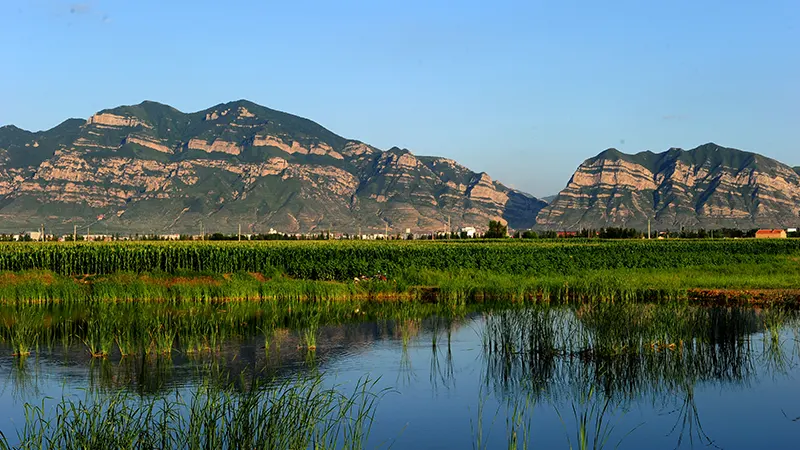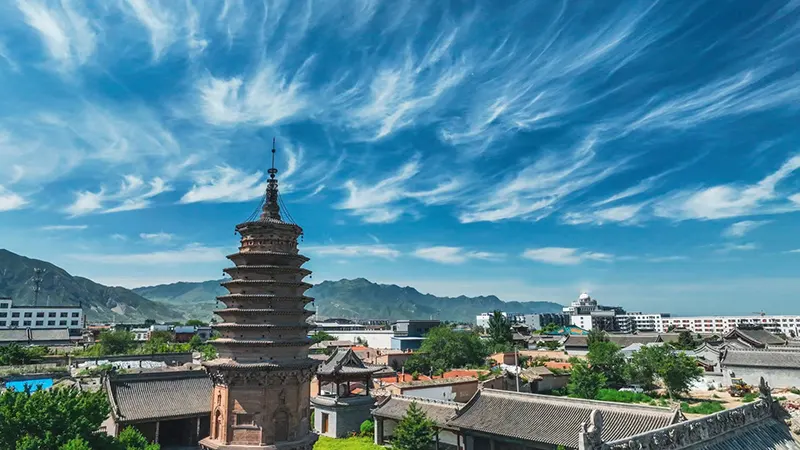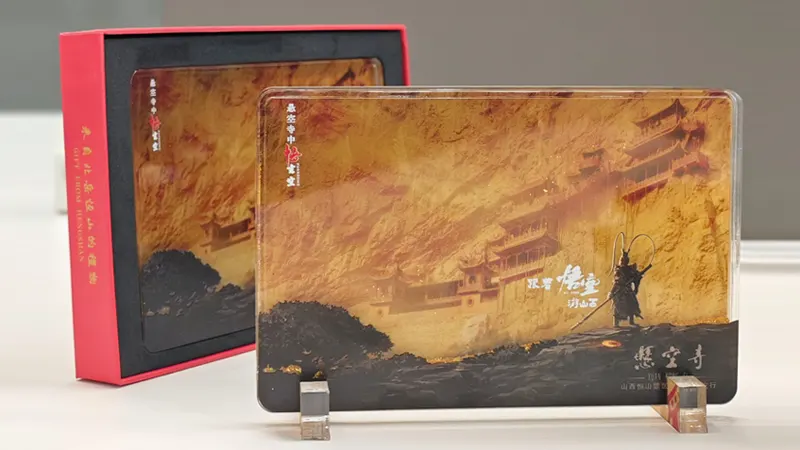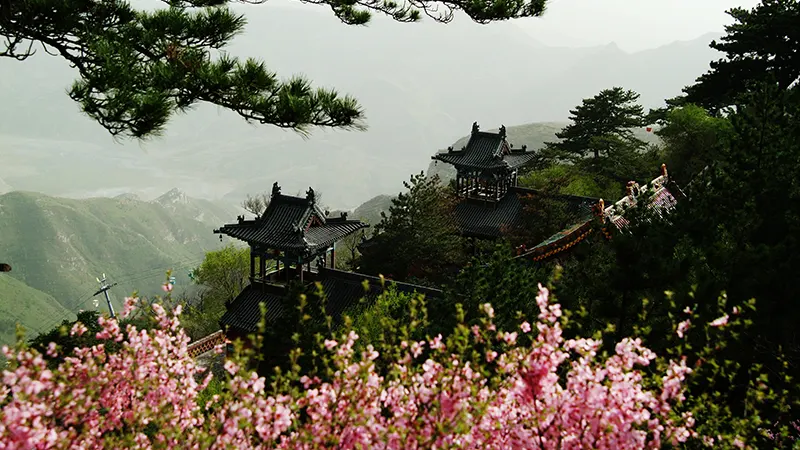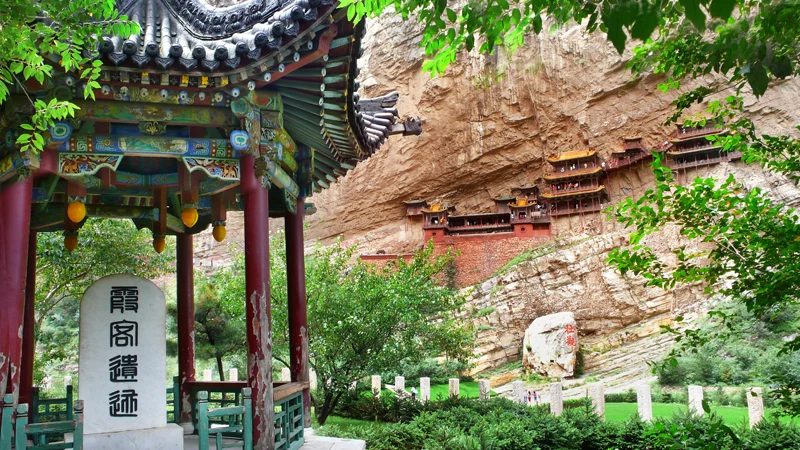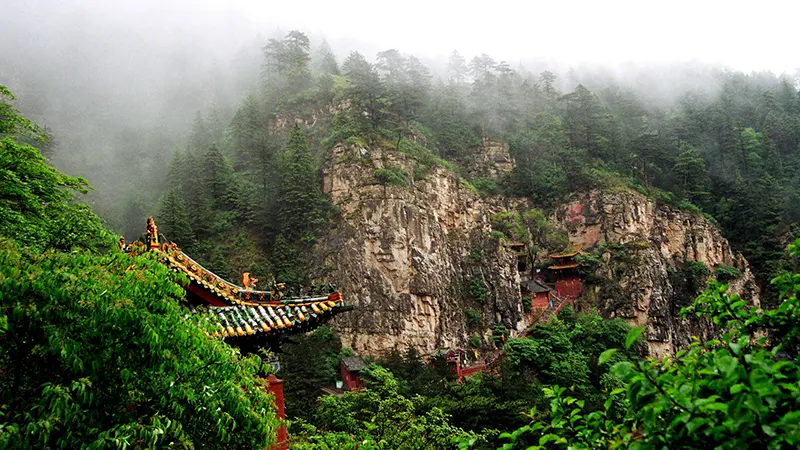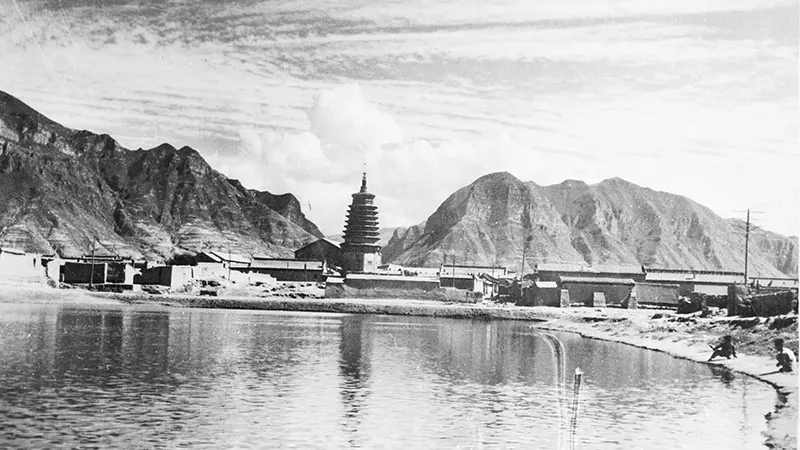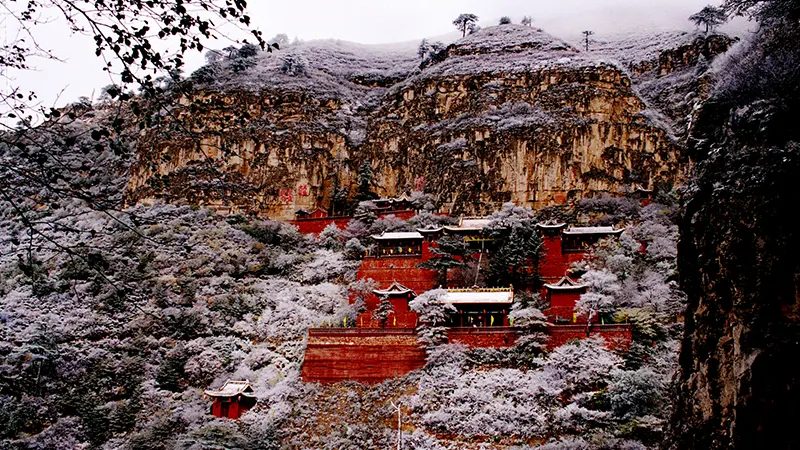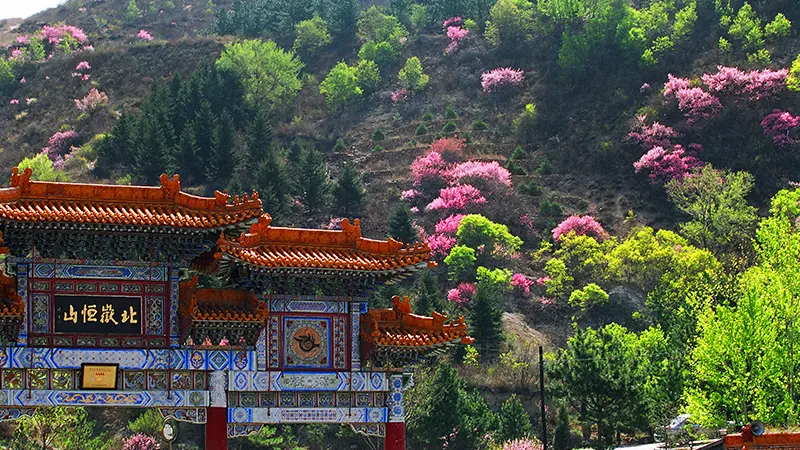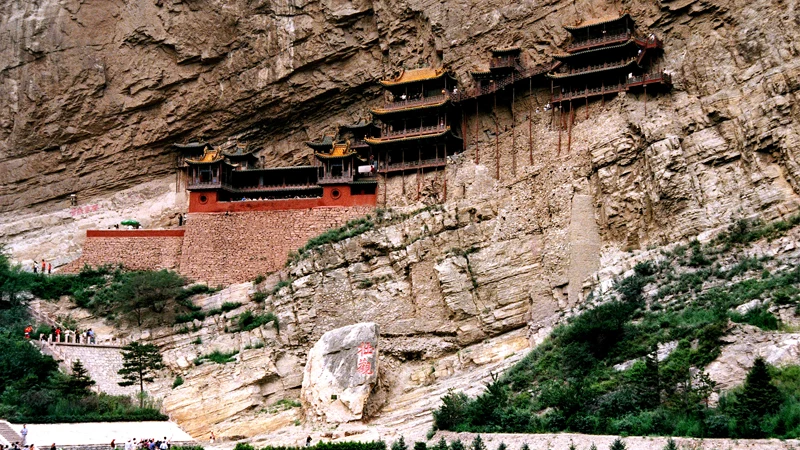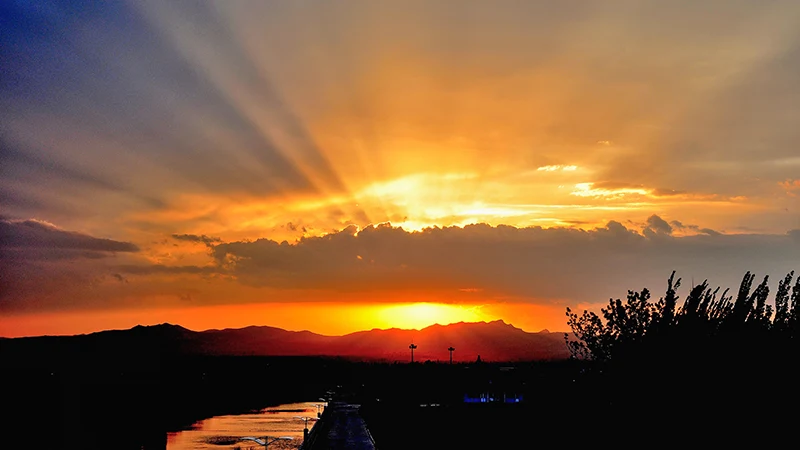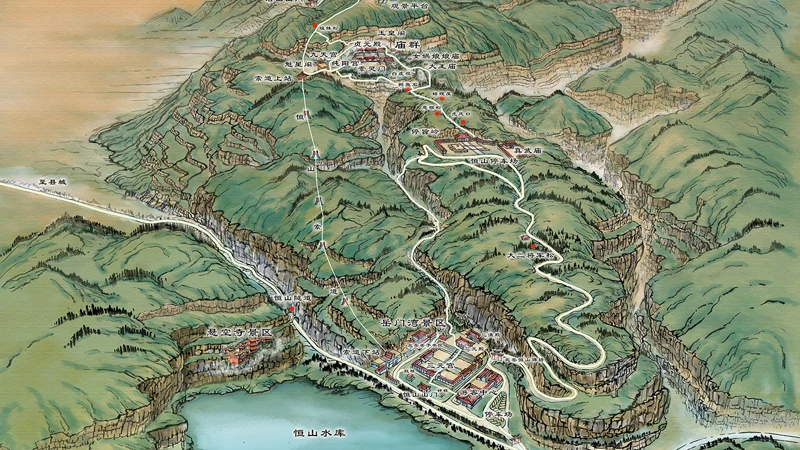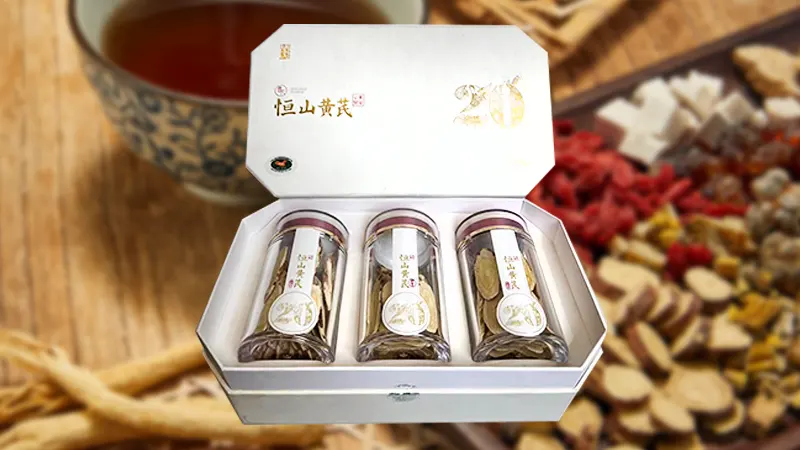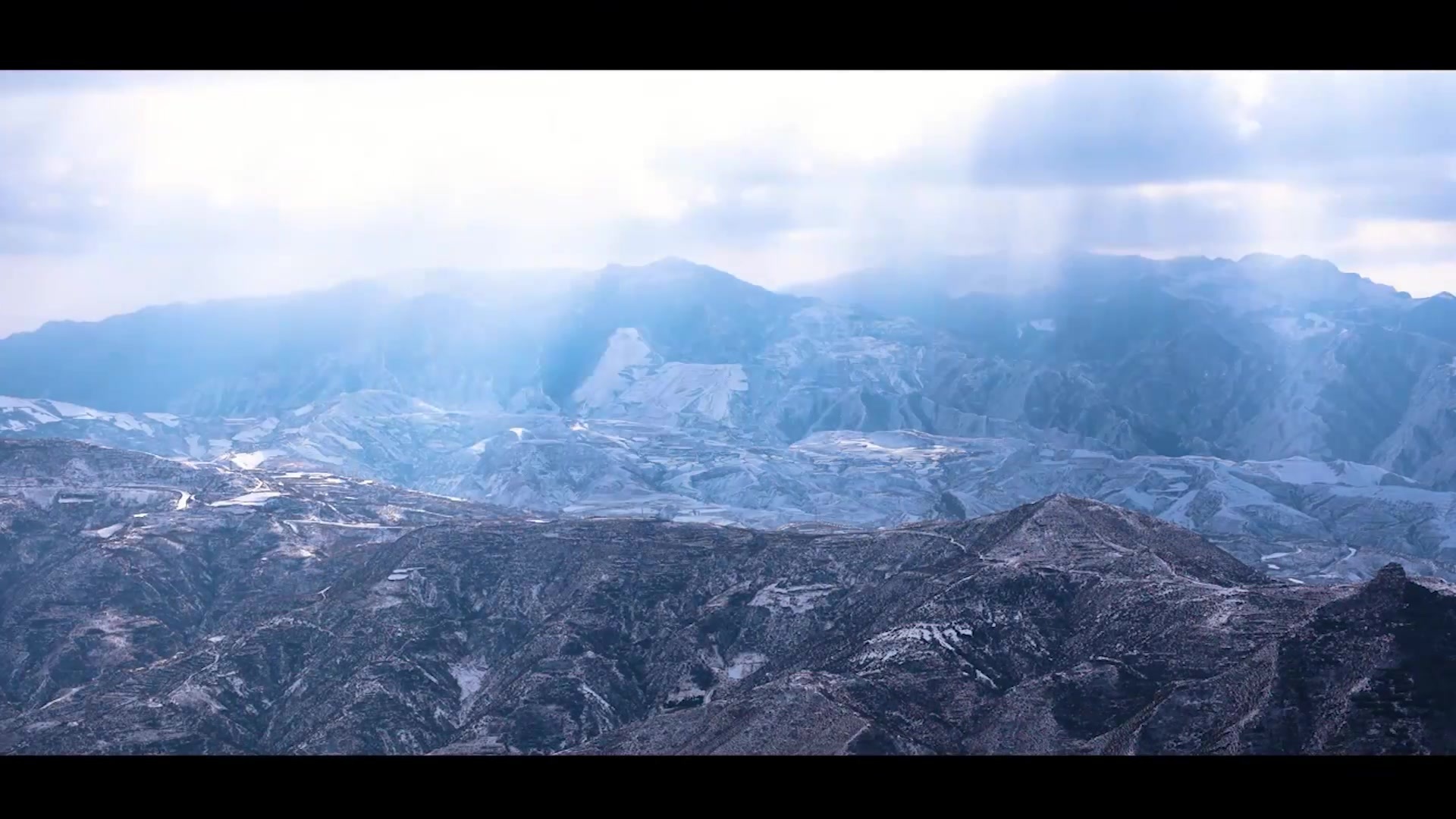Chen Xingya's Travelogue of Yungang Grottoes and Hengshan Mountain in 1935, Republic of China
Publish Time:
2025-03-18 12:21
Source:
Between the September 18th Incident and the Marco Polo Bridge Incident, Chen Xingya held the idle post of council member of the Peiping Pacification Commission, staying at home and often traveling with friends to various famous scenic spots in China.
Editor's Note
Between the "September 18th Incident" and the "July 7th Incident", Chen Xingya held the idle post of Councillor at the Peiping Pacification Headquarters, spending his free time at home and often traveling with friends to various famous scenic spots in China. In 1935, having already visited the other four sacred mountains, Chen Xingya decided to organize a Northwest tour group focusing on Hengshan Mountain, Datong Yungang Grottoes, Wutai Mountain, etc. The purpose was not only to tour the mountains and rivers but also to investigate the historical sites and construction in the three provinces of Shanxi, Chahar, and Suiyuan, to increase knowledge of the Northwest. The plan was to depart around the Dragon Boat Festival, leaving from the Ping-Sui Railway (Beijing to Guisui), and returning to Beijing via the Zheng-Tai Railway (Shijiazhuang to Taiyuan). Fellow travelers included Mo Dehui (字柳枕), the ambassador to the Soviet Union; his son Mo Songsen; his nephew Mo Songtao; Li Mengxing, a school director of the Northeast Middle School in Peiping that sheltered refugees from Northeast China; Li Zhongyu (presumably Li Mengxing's son); and Xiao Biyan, a section chief in Peiping; a total of seven people.
On June 19, 1935, the Northwest tour group departed from Xizhimen Station in Peiping, heading north on the Ping-Sui Railway, arriving in Suiyuan on the 21st. Upon arrival, they were greeted and warmly received by Fu Zuoyi, the chairman of Suiyuan Province. On June 23rd, they took the train to Datong, where they were received by Zhao Chengshou, commander of the Jinsui Army cavalry. They visited the Yungang Grottoes and the Huayan Temple within the city of Datong. On June 24th, Chen Xingya's group traveled to Hunyuan by palanquin carried by mules. This palanquin was exceptionally luxurious and rare, a palanquin carried by camels instead of mules. The cost was exorbitant. At that time, the daily rental for a camel-carried palanquin was 7.5 yuan on the first day and 2 yuan per day thereafter. Only the wealthy and powerful could afford it. While touring Hengshan Mountain, Chen Xingya observed the Flying Stone Grotto and learned of the legend of the "flying stone" traveling from Hunyuan to Quyang. He measured its size and material, planning to personally verify in Quyang whether it matched the stone there. At the same time, he saw numerous cliff inscriptions on Hengshan Mountain and inscribed the four characters "Round, full, and majestic"; Mo Dehui had his son Mo Songsen inscribe the four characters "Great permanence, thus peace." Both were carved on the cliffs. On June 29th, Chen Xingya's group left Hunyuan and arrived at Xin Qulian Village (Xiao Xin Zhuang Village, also known as Xin Kuilian) on the border of Hunyuan and Ying County. During lunch, they chatted with the village elders, learning about the basic conditions and living standards of rural Hunyuan, providing invaluable first-hand information. Afterwards, they traveled through Yingxian, Daiyue, and Yanmen Pass, then on to Wutai Mountain, returning to Taiyuan, and from Taiyuan to Niangziguan and Shijiazhuang, arriving in Quyang on July 17th. In Quyang, Chen Xingya personally examined the flying stone in front of the Bei Yue Temple, comparing its texture and shape with the stone from the Flying Stone Grotto in Hunyuan, confirming that the two were not the same. This disproved the fallacy of the "flying stone" legend. On July 18th, Chen Xingya returned to Beijing, ending his Northwest journey. The trip lasted a month, and throughout their travels, Chen Xingya's group received the highest courtesy from local party, government, and military officials, "with all vehicles free of charge, and food, lodging, and transportation all provided."
In March 1936, Chen Xingya's "Travelogue of Shanxi, Chahar, and Suiyuan" was published by the Jingcheng Printing House. In August 2013, "Republic of China Shanxi Reader: Travel Collection" was published by the Sanjin Publishing House, including the part about traveling in Shanxi under the title "Shanxi Travelogue". This article excerpts the parts of the "Shanxi Travelogue" about Datong, Hunyuan, and Quyang, and retitles it.
Travelogues of modern figures visiting Hunyuan and Hengshan Mountain have always been a focus of this publication. We are publishing this article for our readers.

Chen Xingya (1882-1959), courtesy name Jieqing, was a native of Haicheng, Liaoning. He was a senior Fengtian clique military officer and a scholar-soldier of the old era. He served as Commander of the Three Eastern Provinces Gendarmerie and military officer of the General's Office. At the time of his journey he was a Councillor of the Peiping Pacification Headquarters.
Yungang and Hengshan Mountain Travelogue
Chen Xingya | Text
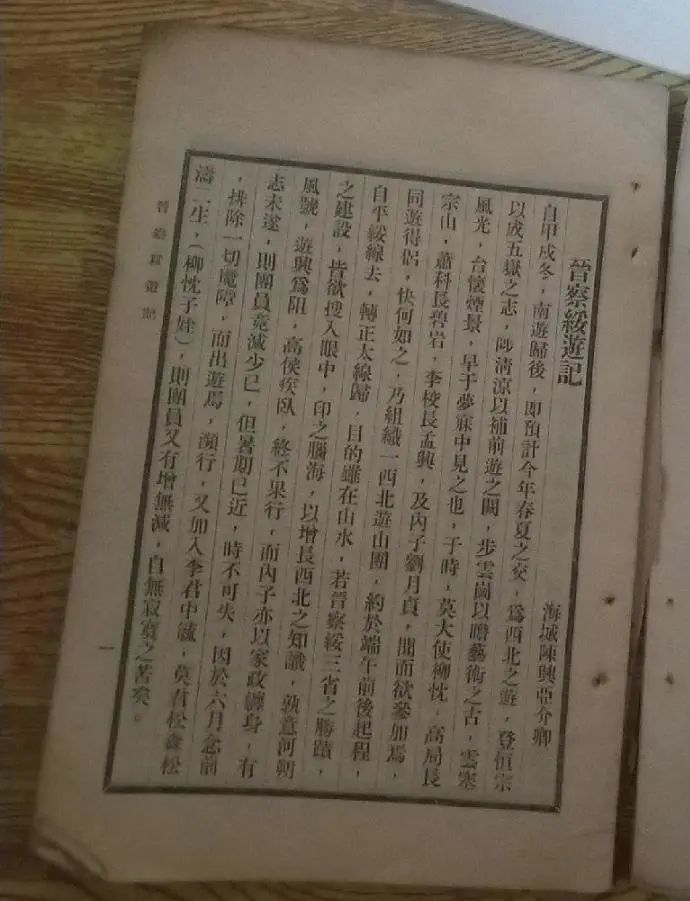
The Origins of "Travelogue of Shanxi, Chahar, and Suiyuan"
Travelogue of Shanxi, Chahar, and Suiyuan
Chen Xingya of Haicheng, courtesy name Jieqing
Since returning from my southern journey in the winter of Jiaxu, I had planned a Northwest trip for the turn of spring and summer this year; to climb Hengshan to fulfill my ambition of visiting the five sacred mountains, to visit Qingliang Mountain to compensate for a previous omission, and to walk through Yungang to admire the ancient art. The scenery of the clouds and passes, and the misty views of Wutai Mountain were already in my dreams. At that time, Ambassador Mo (柳忱), Director Gao (宗山), Section Chief Xiao (碧岩), Principal Li (孟兴), and my wife Liu Yuezhen, heard about it and wanted to participate. With travel companions, what could be better? So, a Northwest mountain tour group was organized, scheduled to depart around the Dragon Boat Festival, going via the Ping-Sui line and returning via the Zheng-Tai line. Although the purpose was the mountains and rivers, the historical sites and construction of the three provinces of Shanxi, Chahar, and Suiyuan were all to be observed and imprinted on the mind, in order to increase knowledge of the Northwest. However, the wind and sand of the Hebei area hindered the trip; Director Gao fell ill, and it was eventually cancelled, and my wife was also preoccupied with household matters. With this failure to fulfill aspirations, the number of group members decreased. But the summer vacation was approaching; time could not be wasted. So before the June holidays, I eliminated all obstacles and set out. Before departure, Mr. Li Zhongyu, Mr. Mo Songsen and Songtao (son and nephew of Mo Dehui) joined, increasing the group members again. There was no more loneliness.
The Two Military and Political Officials who Received the Tour Group
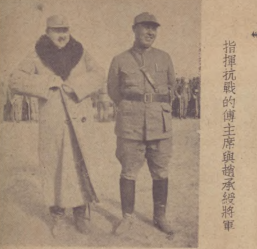

Chairman Fu Zuoyi (right), who commanded the resistance war. The home of Zhao Chengshou, Cavalry Commander of Datong
With General Zhao Chengshou (left), 1936. The villa was built near the Yungang Grottoes.
Trip to Datong
June 23rd, Sunny, 1935
It was decided to take the evening train to Datong today, but Ambassador Mo (柳忱) had insomnia and was afraid he couldn't sleep, so he took an earlier train. We visited Lanshui Spring, thirty li west of the city in the morning. The spring is in the middle of the road west of the village. The pool is only a few zhang in circumference, about five or six feet deep, and flowers spring up from the spring. The pool overflows to the west, forming a stream that irrigates the fields. Near the spring, the willows cast a shade, and the scenery is very beautiful. We lingered for a while before returning.
After lunch, we took the 3 p.m. train east to Datong. The train followed the southern foot of the Yin Mountains. From Maidazhao to Taoshihao Station, the mountain scenery was exquisite, with undulating slopes and ridges. Where the setting sun shone, the contrast between light and shadow was striking. If this mountain were located inland, it would likely rival the Five Great Mountains and the Four Famous Mountains. However, due to its high altitude and remoteness, it remains largely unknown. I plan to revisit Northwest China and climb this mountain to explore its beauty and introduce it to the world. East of Taoshihao Station, the land is fertile, with lush crops, and the opium poppies are still strikingly vibrant. These fields are irrigated, and this type of field is common near Suiyuan City. Water can be found just three or four feet below the surface, making them drought-resistant, but unfortunately, they are relatively few. We passed Pingdiquan at night, a vast plain of grassland. This is the highest point of the Ping-Sui Railway. The night air was bitterly cold, penetrating to the bone, even though it was midsummer; without a cotton-padded coat, one would freeze. From here, the terrain gradually slopes downward. Several miles on either side of the railway, there are lakes and ponds. Legend has it that Su Wu, the Han Dynasty official, herded sheep on an island in the sea north of Datong. This could be the place, perhaps near these lakes and ponds. If we consider the Yellow River south of Baotou, locally known as Nanhaizi (South Lake), then it is understandable that these lakes could also be called seas. After passing Fengzhen, we entered the Outer Great Wall. The site of the city is still vaguely visible. It is said that this city was indeed built during the Qin Dynasty, but the walls are made of earth and are quite low.
We arrived in Datong at 7 p.m., where we were greeted by Commander Zhao, a cavalry officer, the Datong County magistrate, representatives, and Liang, the head of the gendarmerie. We stayed at the Shanxi Provincial Bank, and later, Commander Zhang and his adjutant, Xu, came to entertain us. After dinner, we took a car to visit the Yungang Grottoes.

Panoramic view of the Yungang Grottoes
Illustration from "Travelogue of Jinsui and Suiyuan"
Leaving from the west gate and traveling thirty li into the mountains, we saw yellow and green cliffs towering into the sky, layer upon layer. On the steep rock faces, Buddhist caves lined up, stretching about three li from east to west. The south side of the mountain is entirely covered with these caves. We got off the car at Commander Zhao's newly built villa at Yungang, a hall and a pavilion, quite charming in the mountain setting. After tea, we visited the Buddhist caves. From the villa westward, we entered the Shiku Temple, also known as the Great Buddha Temple. The temple is built into the rock face, and the Buddha statues are carved directly into the rock, sitting over fifty feet tall, with feet over ten feet long. We climbed four stories to see the Buddha's head and face; this is the Great Buddha Hall. West of this is the Tathagata Hall, a square cave about twenty zhang in circumference, with a square stone pillar about ten zhang in circumference in the center. The pillar is two stories high, with Buddha statues carved around it. The four walls have countless niches, each with a carved Buddha statue. The exquisite craftsmanship and ingenious design are unparalleled. Further west of the temple, there are only walls and no temples, such as the First Mountain from the West, the Buddha's Sound Cave, and the Five Buddhas Cave. Their scale is smaller than the Great Buddha and Tathagata Halls, but their solemn beauty and dynamic imagery largely retain their original appearance and have not been repaired. It is a pity that there is so much damage.

Yungang Grottoes Buddha Statues 2
Illustration from "Travelogue of Jinsui and Suiyuan"

Yungang Grottoes Buddha Statues 1
Illustration from "Travelogue of Jinsui and Suiyuan"
There was no way further west, so we returned and exited through the temple gate. Passing through Yungang Lower Fort, we saw a large cave, now collapsed. A large Buddha statue sits in the open air, about fifteen to twenty-five feet tall, still in its original form. Many tourists take pictures here because of its bright and open space. Further west, there are more caves that people can enter. However, there are countless small Buddha caves halfway up the mountain that are visible but inaccessible; it is truly a magnificent sight. At the end of the caves, we climbed the ridge from the west slope and saw a fort, no more than two li in circumference, with cultivated fields inside and no houses, only a gate on the south side. It is said that this is Yungang Upper Fort. In the past, Yungang was an important town in Yunzhong, and forts were built and troops stationed here; this is the origin of Yungang Fort. After climbing the ramparts for a view, we descended and walked down the southeast side of the ridge. Further east, we saw the Cold Spring Cave of the Grottoes. The cave is sealed with mud and cannot be entered. Water flows out from under the cave, very fine, almost dry. There are many more caves to the east, all damaged and incomplete. However, there are many inscriptions on this section of the rock wall. Because the stone is not strong, most of it has peeled off, and it is difficult to decipher them.
Yungang is known as Wuzhou Mountain and belongs to Zuoyun County. Originally, there were ten temples in the grottoes: Tongsheng, Lingguang, Zhen Guo, Huguo, Chongfu, Tongzi, Nengren, Huayan, Tiangong, and Doushu. They were built during the Northern Wei Dynasty under Emperor Tuoba, when Datong was the capital. It took over a hundred years to complete, and its exquisite artistry has been praised by people both inside and outside China. Unfortunately, only one or two temples remain today, and many caves are buried. The stone Buddha statues are either eroded by wind and rain or stolen and sold by antique dealers. Many are incomplete. Recently, under Commander Zhao's initiative, the county government has established a preservation committee to protect them. The area around the Shifo Temple has been encroached upon by residents, obstructing the caves, which is unsightly. It is planned to build a new village to relocate the residents to facilitate the restoration. They also plan to build a levee on the Wuzhou River to prevent flooding. However, complete repairs will require a huge amount of money, which may be difficult to obtain. After my visit, I wanted to leave a souvenir, so I asked Mr. Zhang Qian, a member of the preservation committee, for permission to inscribe the three characters "Xiaoxitian" (Little Western Paradise) on a blank stone in the first cave west of the temple.
Then we returned to the city and visited the Upper Huayan Temple. Built during the Tang Dynasty, its Great Hero Hall has eighty-one rooms, making it a grand scale and the largest Buddhist hall in the world. The wooden frame is still the original one, unshaken, showing its strength. The exquisite statue of Weituo is also unparalleled. We then visited the Lower Huayan Temple, also built during the Tang Dynasty. Originally, it was one temple with the Upper Huayan Temple, but later it was divided into two. This temple is famous for its exquisite and beautiful statues. Due to the hot weather, we hurried back to our lodgings.
In the evening, we attended a banquet hosted by Commander Zhao. As he was away in Taiyuan, Commander Zhang and Adjutant Xu hosted in his place. During the dinner, we discussed the customs of Datong. Although foot-binding is officially banned, women still participate in "showing-off-feet" gatherings. Women, regardless of their wealth, are generally neat and clean in their appearance, while men remain dirty. People's lives are very simple; each person can live for a year on three or four gold (editor's note: referring to three or four taels of silver). I was skeptical, but Mr. Zhang said that potatoes and oil wheat (editor's note: referring to Tartary buckwheat) are the cheapest foods, and people mainly eat these. This shows the frugality and hardship of the people of Shanxi, which is unmatched by people from other provinces, and is also a characteristic of the people. There is coal everywhere, and everyone can mine it. There are many small factories, and few imported goods are purchased. This is another advantage, as it prevents the outflow of profits. However, there is a great deal of laziness, and progress is slow. This requires those in power to provide appropriate education. I am unsure if my observations are accurate.
Today is still the Guan Yu Temple fair, so we went to observe the customs. However, the crowd was immense, and we could not get off the car, which shows the depth of their superstition. We then returned and prepared for our trip to Hunyuan tomorrow. 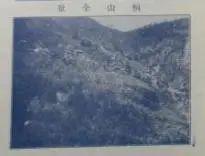
Panoramic view of Hengshan Mountain
Illustration from "Travelogue of Jinsui and Suiyuan"
Trip to Hunyuan
June 24th
At 8 am, departing from Datong, I rode a camel sedan chair out of the south gate. I went around to the east gate and took a view of the Cao Fu Temple. The temple is located on Guo Hua Mountain, where it is said that Cao Fu froze to death. The temple worships Guan Di and Sakyamuni. There is a side hall with a statue of Cao, made by a certain Datong magistrate during the Qing dynasty. After a short stay, I left and headed straight for the Hunyuan road.
Five li to Sha Ling, six li to Twelve Villages, three li to Xiao Nan Tou, seven li to Ai Zhuang, two li to Tan Er Cun, eight li to Shang Quan, I had tea here. Ten li to Zhou Jia Bao, five li to Luo Zhen Ying, five li to Li Ren Zao, eight li to cross the Sanggan River, entering Ji Jia Zhuang, I stayed overnight here. The village shop was cramped and dirty, making it inconvenient to eat and sleep; however, my enthusiasm for mountain touring was strong, and I am used to staying in small shops, so I did not feel any hardship and found it quite interesting.
June 25th Sunny
Departing from Ji Jia Zhuang, I first walked and then rode a horse. Ten li to Yongchengkou, fifteen li to Songshuwan, five li to Nigou. I had lunch in a relatively cool earthen kiln. Five li to Yulin, eight li to Jiangjiagou, twelve li to Tuqiaobao, ten li to Hunyuan County.
The commander of the garrison, High, and the county magistrate, Zhao Lin Li, and the chief of public security came to greet us at the western suburbs, and they lined up to welcome us. As we were on a private tour, the welcome we received from these civil and military officials was almost like a disturbance, and I felt uneasy, but there was nothing I could do, so we got off the car at the Slaughter Tax Bureau, which had been prepared by the county government.
The county magistrate also hosted the dinner. We planned to climb Hengshan Mountain the next day.

Hengshan Mountain Hanging Temple
Illustration from "Travelogue of Jinsui and Suiyuan"
June 26th Sunny
There was a heavy thunderstorm last night, and the weather is cool and refreshing, the mountain city is bright and clean. I set out at 7 am to climb Hengshan Mountain.
The mountain is ten li south of the city, and I rode a horse to go there. Looking at the south side of the mountain, its peaks are like two breasts rising from the ground, full of capacity and nurturing, not showing any sharp edges. Compared to other mountains with rugged peaks and uneven ridges, they are incomparable. Eight li to Tangjiazhuang, from here, I entered the mountain, which is the entrance to the porcelain kiln, located on the right side of the mountain. Because of the rain, the sound of the streams was surging and refreshing to the ears. To the west is Longshou Mountain, and to the east are several beautiful peaks of Hengshan, sheer cliffs, and breathtaking views, but there is no shade of trees, only green grass.
Following the stream south, you can see buildings soaring into the sky, houses and pavilions overlapping, clinging to the wall and overhanging with no ground beneath, this is the Hanging Temple. The temple is built against a sheer cliff, layered upwards, supported only by more than a dozen thin pillars, which are all floating and do not shake at all. Those who built it truly possessed superb craftsmanship. Going up the stone steps from the south, I first entered the Taoist residence. Past this are the Buddha halls and shrines, overlapping and spiraling up and down, I don't know how many floors there are. There are many inscriptions on the walls, mostly relics from the Ming Dynasty. Only one inscription is from the Da Ding era, indicating that the temple already existed in the Jin Dynasty, but its founding date is still untraceable. While sightseeing, I felt fear and awe. Below this is a bridge base; the bridge itself is not finished. Only on the left and right mountain walls are dozens of square holes made for building the bridge. On the right wall, "Yun Ge Hong Qiao" (Cloud Pavilion Rainbow Bridge) is inscribed, which refers to the bridge and the Hanging Temple. Legend has it that in the past, there was a pool here, and the cliffs on both sides were impassable. Those who climbed Hengshan had to detour through Longshou Mountain. Now, the pool is silted with sand and stone, so a wide road has been formed. Turning from the southwest, on a large stone surface to the left of the road, there is an inscription by the censor Wang Xianchen: "Tai Bai's Remains." According to legend, Li Bai once drank wine there. Further to the right and halfway up the mountain are the Luohan Cave and the Da Mo Cave, which have nothing worth seeing.
After walking a few more li, I passed by two or three places where coal was mined using traditional methods, then arrived at the mountain gate, where there is a large archway with the words "Hengshan Mountain" inscribed, written by the Ming Dynasty censor Liu Yu, next to which is a stele that reads "The First Mountain of the North," without a signature. Entering the gate is the San Yuan Palace. From here, I climbed the mountain heading northeast. Coal was exposed on the mountain slope, and people were mining it. Several li of walking up the cloud road, it was steep and short. Further up are three big pine trees, this place is called "Five Great Ministers' Pine Trees," also borrowing the meaning of the pines that Qin Shi Huang sealed on Mount Tai. From here, looking at the front of Hengzong, the view was unobstructed. There were no strange peaks or strange rocks, and its shape was not much different from the back. Only two peaks rose roundly, facing each other east and west, with the west peak being the main peak, and the Yue Temple located below it. The two peaks extend toward the southwest and southeast, like a pair of wings flying down, similar to the Taihua Mountain. However, the south side has no barrier and is too exposed. On the slope below the left peak, there are still hundreds of cypresses and pines, and the rest is barren. Below the two peaks, blue buildings in yellow and green colors are scattered high and low like morning stars. Their beautiful shape and charming scenery, although not as good as the quiet stone valleys of Tai, the secluded space of Heng, the outstanding three peaks of Hua, and the beautiful stone streams of Song, but in the cold north, this beautiful scenery is the best in Yun.
Further northwest, I arrived at the Ting Zhi Ridge, where emperors of all dynasties stopped to offer sacrifices to the mountain and received the imperial decree before proceeding. There is a small village on the ridge, which is very poor. Passing the Zhenwu Temple to the north, I went through the Da Zi Wan. On the cliff to the east of the bay is the inscription "Hengzong." I followed the bay and climbed the hill to the inscription. Examining the inscription, it was about a zhang long, written by "Zhang Gao, the Grand Commander, Prefect of Datong Prefecture, respectfully inscribed it on a propitious spring day." (It's uncertain if the character 'Gao' is correct due to erosion). Next to it are two smaller characters "Hengzong" in clerical script about a foot long. There is a Jiajing era name, possibly inscribed at the same time?
After viewing it, I returned to the original road, and entered the Hu Feng Kou to the north, where there is an archway. I heard that in the 14th year of the Republic of China, the Northwest Army defeated the Jin Army here, with many casualties. North of the archway is a stele with the words "Jie Shi" (Jie Stone) inscribed by Dong Xi from the Ming dynasty. Several dozen steps further north is the Guo Lao Ridge, with donkey hoofprints, probably made by someone who appreciates the scenery. Another li northwest, I entered the Yue Temple area. I went to the reception hall, passed the Ten Kings Hall, there was a Xuanwu Well, two wells, one sweet and one bitter, and the bitter one is already dry.
Further east and upwards is the sleeping quarters (old palace), below which is the dressing building, to the left is the Huan Yuan Cave, and to the right is the Fei Shi Cave. The cave is about one zhang high, six or seven feet wide at the bottom, and over two feet wide at the top; the depth is no more than eight or nine feet. On the outer wall of the cave, there is a poem by Hu Ruji that refutes a fallacy:
The traces of axes and chisels are still there, One stone does not need to be locked in Quyang. Since then, rumors are hard to believe, Yu Ting has never seen the king.
Historical records indicate that since the reign of Emperor Wu of the Han Dynasty, the Northern Mount Heng has been worshipped in Quyang. This is attributed to a legend of a stone fragment that flew to Quyang during the time of Emperor Shun, and also to the fact that the Yunzhong region was repeatedly invaded by the Northern Xiongnu, leading to the relocation of the worship to Quyang. This continued until the end of the Ming Dynasty, when the official rites were revised, a new temple was built, and the old temple was converted into a sleeping palace. Thus, there are the distinctions of Hengshan Mountain in Hunyuan and Hengshan Mountain in Quyang. In truth, the legend of the flying stone seems rather far-fetched, and merely refuting it with idealistic classical Chinese writing is not enough to clarify the matter. I intend to visit Quyang personally, to carefully examine the shape and quality of the stone to see if it corresponds to the cave. If there are any discrepancies, the error will become self-evident.
On the stone walls outside the palace, there are inscriptions such as "Yunzhong Scenic Spot" and "Yide Peak," among many other poems and inscriptions, mostly from the Ming Dynasty. I proceeded to the Longquan Temple within the Hengshan Temple, locally known as the "朝殿," where the abbot, Gao Yuanqing, personally welcomed and hosted me.
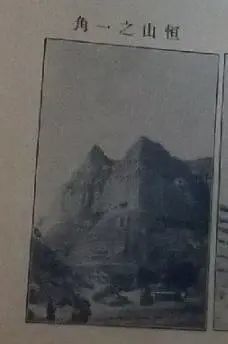
A corner of Hengshan Mountain
Illustration from "Travelogue of Jinsui and Suiyuan"
After lunch, I continued eastward to visit the Wenda Temple and Deyi Hermitage. Both temples were named after and dedicated to hermits who had attained enlightenment on this mountain. Returning to the main temple and exiting from the left gate, there is a "Chicken-Crowing Stone." Striking it with a small stone produces a sound like a chick, similar to the Chicken-Crowing Stone outside the north gate of Shanhai Pass. Traveling southwest, I entered the Hui Xian Mansion. Behind the mansion are inscriptions such as "绝地通天" and "昆仑长脉," and to the right, "灵山耸秀" and "名齐四岳." A few dozen steps further, I reached the Qinqutai (qin and qi platform), located on a steep cliff face. I climbed up through a crevice in the rock; the climb was extremely steep and dangerous, fortunately short, avoiding major difficulty. At the top is a chessboard, said to be the place where immortals played the qin and chess. The area is very limited, only accommodating two or three people. Beside the chessboard is an inscription that reads "一局烂柯," and on the wall, "悟道遗迹." There were other inscriptions, but the angle of the wall was difficult, and I did not dare to look up.
Passing through Tongxuan Valley, I went around to the south side of the mountain to climb to the summit, Tianfeng Ridge, where Liu Chen and his son had already arrived. Previously, Mr. Song Tao and Mr. Song Sen, wanting to visit an old Daoist hermit in a hard-to-reach cave, found it impossible, and therefore directly climbed to the summit, but Liu Chen arrived first. The summit is like a steamed bun, with little exposed rock. Looking around, to the north was the Hunyuan county city, quite neat and orderly, shaped like a spider web or Bagua, densely populated without a single gap.
Further north is Yuhuafeng, looming protectively; to the east, it connects to Baishan, appearing intermittent; to the south, it connects to Qiangfeng Ridge, looking like a screen; to the west, it faces Cuiping Mountain, with a spectacular view. Looking further south, three hundred miles away, the peaks of Wutai Mountain are visible. According to the "Cave Heaven Records," Hengshan Mountain has a circumference of 130 li; according to "Blessed Land Records," Hengshan Mountain is 3,000 zhang high (If we calculate 20 li to a zhang, the difference is insignificant; however, the height of a mountain should still be measured by elevation. At that time, although they did not know about elevation, it was not as far as that).
The tour group gathered, singing and enjoying themselves. The wind blowing from the north was very pleasant and refreshing. Although it was desolate in the north, we did not feel cold. In high spirits, we sang spontaneously. I asked Meng Xing to conduct, and his students, the Song brothers, sang the national anthem. Afterwards, he performed a solo of "The Great Wind," his voice reverberating through the valleys.
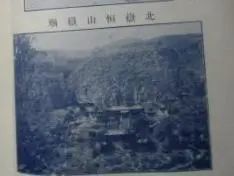
The Hengshan Mountain Temple
Illustration from "Travelogue of Jinsui and Suiyuan"
As the day was already late, we descended from the north side of the mountain. I had a cold and felt chest pains and weariness, unwilling to exert myself further; Biyan, however, took the lead in climbing a secondary peak. We, unwilling to be outdone, followed in turn, all being quite fit. After a short rest, we walked down through an oilseed field and into the main path, observing Zhizhiyu. We didn’t find any Zhizhi but found that the Stone Fat map had disappeared. We passed by Baiyundong (White Cloud Cave), situated on an inaccessible cliff, which we could only admire from below, appreciating the inscription "白云灵穴." All along the route were steep and dangerous slopes, making the descent difficult despite its downward inclination.
Reaching the Hengshan Temple, I looked up at the wall inscriptions: "瞻圣," "云中胜览," "天下名山," "天地大观," "壁立万仞," and "夕阳返照." All these are located on cliffs and precipices. Other smaller inscriptions were too small to decipher clearly. Inside the temple were numerous steles dedicated to Mount Heng; only one was from the Yuan Dynasty, the rest from the Ming and Qing Dynasties. Other Mount Heng temples are located at the foot of the mountain, but this one is located on the mountain itself; its scale is also smaller, restricted by the mountain's terrain. Perhaps because there is no open space in front of the mountain, or because the scenery behind the mountain is not favorable, and because the mountain's left and right sides are connected to other mountains, it was therefore built in this location? Such a judgment is not unreasonable.
Due to slight indisposition, I went to bed early that night. I reflected upon Hengshan Mountain and how, to avoid the names of Emperor Xiaowen of Han and Emperor Zhenzong of Song, its name was changed to Changshan, also known as Yuan Yue, Zhen Yue, Yin Yue, Zi Yue, as well as Tai Hengshan, Da Mao Shan, and Shen Jian Shan. Some believe that Hengshan Mountain lacks unique peaks and stones and is not rich in natural beauty and thus has nothing to see. They do not know that its mountain range originates from the Yinshan Mountains, extends into Suizhou, turns westward and eastward, forming Gouzhu, Fuyi, Xiawu, Ruyue, Shuyai, and finally emerges south of Hunyuan Prefecture, becoming Hengshan Mountain. Extending south to Taihang and Wangwu Mountains, southwest to the Yellow River, eastward to Zijin and Juyong Passes, northeast to the sea, it encloses the whole of Shanxi province, spans Youzhou and Yan, controls Yamen in the west, and surrounds Daigun in the north. Its strategic position dominates the border, commands the central plains, and is the most important location in the world. Furthermore, the five sacred mountains that are chosen as sacred mountains are not necessarily due to their scenery, produce, geographical features, or size, but also because of their ability to produce clouds and rain, benefit the land, stand firm, nurture all things, and manifest their majestic spiritual power. The significance of Mount Heng lies in this.
I cannot evaluate it, only to say it is "round, full, and majestic." Let those who observe it consider this point.

Cliff Inscription: Round, Full, and Majestic
Inscription: Inscribed by Chen Xingya of Haicheng

Cliff Inscription: Great Heng, Ensuring Peace
Inscription: Inscribed by Mo Songsen, Student of Nankai University
June 28th, Morning Cloudy, Afternoon Sunny
I wrote the four characters "Round, Full, and Majestic" and the public inscriptions. Liu Chen initially wanted to leave an inscription and had drafted the four characters "Great Heng, Ensuring Peace." I had already selected a stone for him, but then he changed his mind about leaving his name and asked his son Songsen to write it instead.
After breakfast, I visited the hermit Wang Yiying (字渭生) at the Ten Kings Temple. Mr. Wang was from Puxian County, Xuzhou. He came here to live in seclusion two years ago with a servant. He was sixty-three years old, his hair and beard were white, but his spirit was still strong. He claimed to have long admired the peace and tranquility of Shanxi Province and had come here to avoid the chaos. He claimed to be a farmer, but his speech and manner suggested otherwise. I suspect he had seen through the world and had become a great hermit. From there, we passed by the Pure Yang Palace, the Nine Heavens Palace, the ruins of Cui Xue Pavilion, and Kui Xing Tower, and descended the mountain by the mountain path. Although this path was shorter, it was steep and covered with loose rocks, making it easy to slip. Many of my companions found it difficult, and Liu Chen said that even the Huashan Mountain path, known for its danger, was not as difficult as this. He was right. However, Song Tao, Song Sen, and I descended quickly, not daring to stop, but I don't know how many times we almost fell.
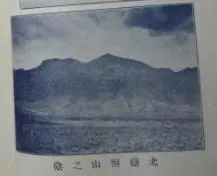
Hengshan Mountain's shadow
Illustration from "Travelogue of Jinsui and Suiyuan"
Upon reaching the foot of the mountain, since the horses had not yet arrived, we walked into the city. I went to bathe, and when I finished, the other travelers returned. After dinner, I climbed the drum tower to view the entire city. The houses were closely packed together, the streets and alleys were neat and orderly, there was no sign of corruption, but life was simple and extremely difficult. Going out of the east gate, I visited the tomb of Su Gongqin. Its scale was as grand as that of a king or prince. Su Gongqin was a governor who made outstanding contributions to river control. He died when the Yellow River burst its banks, and the so-called "Four Great Kings of the Golden Dragon" is his spirit. The locals confirmed this, and his descendants' homes are still within the south gate, their family's status remaining high to this day.
On the way back, I paid a return visit to Commander Gao and County Magistrate Wang (Han's note: should be County Magistrate Li). In the evening, I packed my luggage, preparing to go to Mount Tai tomorrow, see Yanmen Pass, and then go to Qingliang Mountain. 
Inside pages of "Travel Notes of Shanxi, Chahar, and Suiyuan"
June 29th Sunny
We left Hunyuan in the morning and went to Daiyue Town. The military and government officials lined up to see us off again, making me feel very grateful and ashamed.
Fifteen li to Shuimo Village, ten li to Jiazhuang, two li to Tiancun, five li to Guguang, five li to Xifangcheng, five li to Yijiazhai, seven li to Xin Qulian Village, where we had lunch. I chatted with the villagers and learned about the local social conditions and the extremely simple lives of the residents. The richest people spend less than three yuan a month, while the poorest spend only one yuan and five cents; the daily wages for farmers and workers are ten cents during the busy spring and autumn seasons, and five cents otherwise; school teachers earn only seventy or eighty yuan a year, which is considered average, with the lowest earning thirty or forty yuan; the burden of national and local taxes is one yuan per person on average; their daily diet consists mainly of millet and sorghum, made into cakes and flour, not rice. The sorghum is ground with the skin on, indicating its coarseness. They only eat white flour once a year on New Year's Day, and meat is unheard of; each mu of land yields only two dou of grain, even less in bad years. This shows the poverty of the land and people in northern Shanxi. As for foot-binding, it has not completely disappeared, and schools are few and far between. Their tools, carriages, clothes, and shoes are still the same as they were decades ago, which shows the conservative nature of the Shanxi people, and their progress is naturally slower. However, few foreign goods are imported, and most goods are locally produced, which also helps alleviate poverty, in line with economic principles.
After lunch, we continued on, eight li to Luojiacun, twelve li to Tianjiafang, ten li to Zhenziliang, and fifteen li to Yingxian County.
We arrived in the city at dusk. County Magistrate Wang Huangge and Public Security Bureau Director Li Youtang, along with others, welcomed us at the east suburbs. We got off the car at the Guoheng Pawnshop, the place prepared by the county magistrate. Sun, a member of the Chamber of Commerce and the manager of the pawnshop, greeted us warmly. After dinner, we took a walk in the courtyard and saw many farm tools, all pawned items. Each item was only worth one or two cents of silver, which shows the poverty of the farmers. I asked the county magistrate and others about the transportation conditions to Mount Tai, Yanmen Pass, and Wutai Mountain, and then went to bed.
June 30th Sunny
I got up in the morning, paid a return visit to the county magistrate, and then climbed the Yingzhou Pagoda, also known as the Jin City Pagoda, because Yingzhou was called Jin City during the Liao Dynasty. It is also called the Sakyamuni Pagoda. There is an inscription from the second year of Qingning in the Liao Dynasty, indicating that the pagoda was built before the Liao Dynasty. The pagoda has four levels, like a four-story building, each with Buddha statues. The pagoda is about 360 feet (or 180 feet) high and is made of wood, except for the base, which is made of bricks and stones. It has stood for more than 900 years since the Liao Dynasty without any damage, still standing tall in the sky. It is not only strong, but its exquisite craftsmanship is also a masterpiece of art.
After descending the pagoda, we left the west gate with the local officials seeing us off. Ten li to Kouzhai, ten li to Qinzhuang, ten li to Nanjiazhai, five li to Mizhai, three li to Dongba, five li to Kangzhuang, eight li to Lijiahuayuan, two li to Gaosuantuan, five li to Wangzhuang, five li to Daiyue, and stayed at the Liuhe Inn.
That evening, Zhao Mingxuan, the county magistrate of Shanyin County, came to visit and left after a short conversation.
Because I was worried that there would be no seats on the long-distance bus to Yanmen Pass, I sent a telegram to Commander Zhao in Datong to borrow a car, and he agreed, so the journey tomorrow will be more convenient.
…
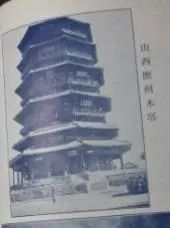
Yingzhou Wooden Pagoda, Shanxi
Illustration from "Travelogue of Jinsui and Suiyuan"
Trip to Quyang
July 16th Cloudy
At 8 am, I took the Zhengtai train east from Taiyuan and got off at the foot of Niangziguan to take a look. It was raining lightly, but I didn't mind.
The gate is about a mile east of the station. The outer gate has the words "Niangziguan" inscribed on it, named after Princess Pingyang of the Tang Dynasty, who once guarded this pass. Inside the pass is a village called Dakou, and outside the pass is a village called Xiaokou. North of the pass is a stream, with the sound of flowing water. The railway and iron bridge cross it. The situation is not very dangerous, but the mountain gorge is long, about 400 li inside and outside the pass, which is unmatched by Juyongguan and Yanmenguan. In the past, it was easy to defend and difficult to attack, but now, with airplanes and bombs, it is difficult to defend and easy to attack. However, this is a new pass. Fifteen li south of this pass is Gu Guan, the old pass, which is considered more dangerous. Looking from the new pass, I saw a high mountain to the south, called Mian Mountain. Is this the Mian Mountain where Jie Zitui was burned to death? No, the mountain where Jie Zitui died is in Jiexiu, hundreds of miles from here. However, whether it is the real Mian Mountain or not, I must climb it to feel satisfied. So I invited my companions to climb it, but they were afraid of missing the train, so no one responded, and I went alone. The road was very steep. There is a watchtower on the mountaintop, commonly known as Princess Pingyang's Summer Resort. The tower is mostly dilapidated. I rested there for a while and then climbed to the highest peak. According to the guide, you can see Jingxing from here. However, due to the overcast rain, the mountains were hazy, and the distant view was obstructed. I wanted to take some stones back, but I couldn't find any good ones on the peak. Then I suddenly found a stone with some characters on it. Upon closer inspection, it was a stele of Jie Zitui, erected by a Ming Dynasty person. Jie Zitui was a meritorious minister of the Jin Dynasty. He did not seek personal gain after his achievements, and he is admired by people throughout history, especially the people of Jin, who revered him like a god. There are many steles erected on the mountains to pray for rain and ward off disasters, hence the stele of Jie Zitui. Therefore, the mountain is named Mian Mountain, but it is not the real Mian Mountain.
He picked up the remaining stone tablet fragments and went down the mountain, resting for a while at the swimming pool by the train station. The pool, newly built using water diverted from the mountain, was not yet complete, but the water was vast and pleasingly clear. A fellow villager, Mr. Wen, happened to be there investigating places of historical interest. He mentioned that there were many famous historical sites inside and outside this pass, and that Director Zhu was planning to build a scenic area here, which was also part of the railway's plans.
After 5 pm, a car arrived, and I took it to Shijiazhuang, staying at the Zhengtai Hotel. Mr. Gao and his second brother came to chat and treated me to dinner. From here, we entered the tropics, no longer the cool climate of Shanxi.
July 17th: Cloudy in the morning, then sunny.
The group planned to split into two groups to return to Ping. One group would go directly to Qianmen, including Liu Chen and his nephews; the other group would get off at Dingxian County and go to Quyang to investigate the flying stone at the Beiyue Temple, including myself and Messrs. Xiao and Li.
At 8:30 am, we boarded the Pinghan train heading north. After 10 am, we arrived at Dingxian County. We got off the train and took a sedan chair west. Passing through Gande Village, Zao Village, Gaomen Town, Gaomen Village, Xinzhuang, and Qili Village, we arrived at the Quyang County town after sixty li.
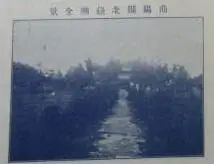
Panoramic view of the Beiyue Temple in Quyang County, Hebei Province
Illustration from "Travelogue of Jinsui and Suiyuan"
The town was quite small and desolate. Entering the town, we went straight to the Beiyue Temple. The temple is located in the northwest corner of the city. Entering the east gate, we found that people were praying for rain, making it noisy and inconvenient to enter. We therefore first asked the presiding Taoist priest to show us the Flying Stone.
The original Flying Stone Hall had long been destroyed by fire, and the Flying Stone was also destroyed. Only a section remains, no more than three feet wide, less than one foot high, and less than five inches thick, resting on what seems to be a pedestal. The Taoist priest said that the original Flying Stone was three or four feet high, bulging in the middle, and with the characters "Flying Stone" inscribed on top. Now, two-thirds of it has been burned, leaving only the character "Stone". There is also a separate stone tablet near the stone with the characters "Flying Stone" engraved. I compared it with the stones from the Feishi Grottoes that I carried. The quality of the stone is different, and the shape of the stone is also different from the grottoes, so the story of the flying stone is false and obviously untrue.
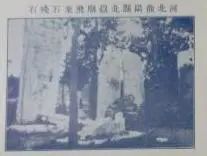
The remains of the Flying Stone at the Beiyue Temple in Quyang County, Hebei Province
Illustration from "Travelogue of Jinsui and Suiyuan"
There are many other steles, pavilions, stone towers, and ancient steles on the walls, mostly sacrificial texts from various dynasties. The oldest ones are from the Northern Wei, Tang, and Song dynasties. All the halls have collapsed, except for the main hall, which is still standing, though its scale, compared to other temples to the five sacred mountains, is inferior. Inside, the god of Hengshan Mountain is enshrined. The murals are very ancient and are said to be by Wu Daozi of the Tang Dynasty, though this is uncertain. The temple is now managed by the county construction bureau. New miscellaneous trees have been planted, providing dense shade and preventing desolation.
It was already evening. We left, bought some rubbings of the temple's steles, and tried to buy or borrow the "Quyang County Gazetteer" for reference. Unfortunately, the old gazetteer was completely lost, and the new one has not been published yet. That evening, we left the city and returned to our lodging in Xinzhuang.
July 18th: Sunny
We left at 5 am and arrived at Dingxian train station after 9 am. The train arrived at 10:30 am, and we took it back north, arriving in Ping at 6 pm in the evening. Our northwest journey ended here, lasting only one month.
The purpose of this trip was Hengshan Mountain, to complete my goal of visiting the Five Great Mountains; to visit Wutai Mountain as the beginning of visiting the Four Great Famous Mountains; and to see the Yungang Grottoes to appreciate the exquisite art of the Northern Wei Dynasty. In the provinces of Shanxi, Chahar, and Suiyuan, I also gained some knowledge of political construction, rural conditions, customs and people, soil fertility, and dangerous mountain passes in the development of the Northwest. The travel expenses were very low because we were travelling as a group for a short period. Train tickets were free, and we received hospitality for food and lodging everywhere. Each person only spent a little over 100 yuan, which was very economical.
Originally published in "Travel Notes of Shanxi, Chahar, and Suiyuan"
Reprinted in "Shanxi Reader of the Republic of China: Travel Collection"
Title added by the editor

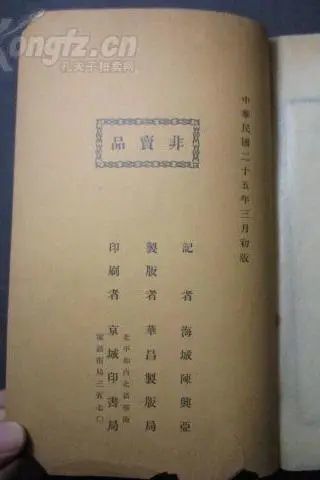
Cover and back cover of "Travel Notes of Shanxi, Chahar, and Suiyuan"
Printed by the Beijing Printing Bureau in March 1936
Proofreader: Xue Fang
Editor: Xing Xuelin
Author's Biography
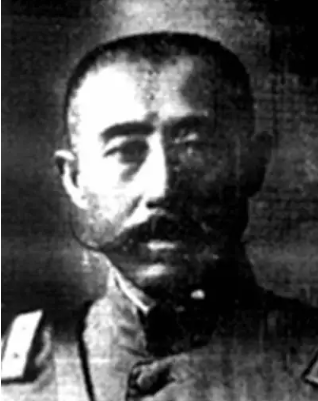
Chen Xingya (1882-1959), courtesy name Jieqing, was a senior officer of the Fengtian clique from Haicheng, Liaoning. A successful candidate in the imperial examination, he initially served as secretary of the Beijing Sulfur Bureau. In 1905, he went to Japan and enrolled in the non-commissioned officer class of the Military Police Training School of the Zhenwu School, graduating in 1910 and returning to China. In 1913, when the Beijing Military Police Battalion was established, he was appointed battalion commander, commanding four companies. In September 1917, he was appointed commander of the Beijing Military Police, and in November 1919, he was promoted to Major General.
After the Zhili-Anhui War in 1920, the Zhili and Fengtian warlords jointly controlled the Beijing government. Chen Xingya, sharing a hometown connection with Zhang Zuolin in Haicheng, became affiliated with the Fengtian clique, serving as a councilor in the State Council and concurrently as commander of the Beijing Military Police. In 1922, the Zhili-Fengtian War broke out, and the Fengtian forces were defeated. Chen Xingya returned to the Northeast with Zhang Zuolin and became the commander of the Northeast (Fengtian) Military Police. In 1924, the Second Zhili-Fengtian War broke out, and the Fengtian army entered the Pass. Chen Xingya was transferred to the post of Chief Inspector of the Beijing Police in November 1926, and in July 1927, he concurrently served as the acting manager of the Kyoto Municipal Government Office. During his tenure, Chen Xingya, under Zhang Zuolin's orders, personally led military and police forces to raid the Soviet embassy and arrest Li Dazhao, leading to his death. For this, he was promoted to Lieutenant General. In 1928, the Fengtian army retreated to the Northeast, Zhang Zuolin was assassinated, and Zhang Xueliang took control of the Northeast, declaring the "Northeast Change of Flags." Chen Xingya became the commander of the military police of the Northeast Frontier Defense Army of the National Revolutionary Army. After the "September 18th" Incident in 1931, Chen Xingya resigned as commander of the military police and became a council member of the Peiping Pacification Headquarters, beginning his leisurely travels. After the "July 7th" Incident in 1937, Chen Xingya resisted the Japanese, refusing to serve in the puppet government and lived in seclusion in Beijing. On the eve of the liberation of Beiping in 1949, Chen Xingya secretly went to Shanghai to hide his identity. In the early 1950s, he was exposed and reported by the masses during the suppression of counter-revolutionaries, was arrested for the death of Li Dazhao and died in Beijing in 1959.

▲ Chen Xingya's name card
Chen Xingya enjoyed touring the famous mountains and rivers of his motherland, including the Five Great Mountains, leaving behind many travelogues, photographs, and cliff carvings. He was a scholar-soldier of the old era. He had an interest and expertise in essay writing, poetry, calligraphy, and singing. During his travels and visits to various places, he often investigated local customs, discovering what had not been discovered before, and offering unique insights and perspectives. In the scenic spots he visited, such as Qianshan Mountain in Liaoning, Xishan Mountain in Beijing, Panshan Mountain in Tianjin, Taishan Mountain in Shandong, Hengshan Mountain and Wutai Mountain in Shanxi, Lushan Mountain in Jiangxi, and Yandang Mountain in Zhejiang, his inscriptions and carvings can often be found. Some of the inscriptions reveal his deep patriotic sentiments. In 1932, after the "September 18th Incident," he carved several inscriptions on the rocks at Xiangshan Mountain in Beijing: "Medicine Stone" on the wall, with the inscription "During the spring of Ren Shen year, while recuperating at Xiangshan Mountain, I came here and my illness was greatly cured, so I inscribed this to commemorate it. Chen Xingya of Haicheng"; "Clear Shame" on the wall, with the inscription "Inscribed in May of Ren Shen year, during the national crisis, Haicheng Layman"; "Gazing at the Liao Sky with Longing" on the wall, with the inscription "In May of Ren Shen year, the year after the September 18th Incident, Chen Xingya of Haicheng." On September 17th of that year, on his 50th birthday, his friends in Beijing wanted to celebrate his birthday, but he hid himself in Xianlong Mountain and inscribed "The country is destroyed and the family is ruined, what birthday is there?" on the wall, with the inscription "Chen Xingya of Haicheng inscribed this on the day before the second anniversary of the September 18th Incident to avoid celebrating his birthday," expressing his worries about the future of his country and family.
The gathering and dispersal of clouds and winds, the traces left by the pen. Articles are the landscapes on the desk, and landscapes are the articles on the ground. Chen Xingya's decades of travels and accumulation of passionate writing resulted in the publication of books such as "Travelogue of Jinsui-Chahar," "Travelogue of Panshan Mountain," "Travelogue of Qianshan Mountain," "Diary of a Trip to the Western Regions Cloud Temple," and "Travelogue of Chu, Yu, and Gan".
Keywords:
Hengshan
Related News


